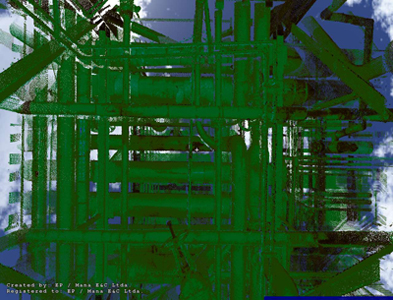3D laser scanning and Intergraph‘s PDS 3D plant design system can pay off even in small plant-modification projects – that’s the lesson of a project executed for leading Brazilian petrochemical producer Braskem S.A. by engineering contractor MANA Engenharia e Consultoria S.A. and service provider Santiago & Cintra Serviços de Medição e Modelamento Ltda.
Braskem operates a high-density polyethylene production plant in the town of Camaçari near Salvador, Brazil. In an expansion of this plant’s unit carried out across 2005 and 2006, three heat exchangers and pump systems needed to be replaced with larger-capacity equipment. Process Engineer Edmundo Barros, the Braskem coordinator of this project, describes how the company had undertaken a similar project ten years earlier and encountered significant clashes during construction. At that time, existing-conditions data was captured “by manual measurement and by referring to the original paper drawings,” he explains. “The drawings were entered into AutoCAD and updated with the manual measurements.” But this procedure was not accurate or complete enough to avoid clashes. “There was very little space to effect the change of equipment,” says Barros, “and there were a lot of problems in construction” which extended the schedule by more than a month.
“This time,” Barros reports, “MANA came to us and proposed laser scanning, and we made the decision to go with it.” What convinced Braskem? “MANA showed us how laser scanning could help avoid the problems we had ten years ago – how it could improve engineering and especially construction, avoiding rework.”
How does MANA win buy-in for laser scanning from owner organizations? Alexandre Brandão de Oliveira, General Coordinator of MANA’s NDT (Núcleo de Desenvolvimento e Tecnologia – Center for Development and Technology), explains: “Our methodology is to show the client what happens when you execute a project without good information about existing conditions – especially what happens in the construction phase. Often we make a presentation to the client with our partner, S & C – we bring the client into our virtual-reality room to visually simulate project operations with laser scan data. That’s a very effective way to convince clients.” The main selling point for 3D laser scanning in MANA’s markets, he notes, is that “almost every owner organization has had bad experiences with modifications caused by inaccurate or missing as-built documentation.”
Camilo Ciuffatelli, Director of Santiago & Cintra, observes that S & C has “a large modeling capability in Brazil, but for MANA we deliver the point cloud and they do the modeling. This is a new strategic business activity for them, not just another tool. They’ve created a competitive advantage for their business by working this way.”
Continued
Work process
Brandão was MANA project manager for the Braskem project. Working with him was Danilo Moreira Bittencourt, NDT Technical Coordinator for MANA. Their team began concept design in January 2005. When MANA and Braskem began negotiating the detail design phase in August 2005, MANA used its VR room to demonstrate to Braskem how executing the project with 3D laser scanning and Intergraph’s PDS 3D design system could minimize clashes. Braskem agreed, and contracted with S & C Technologies to execute the laser scanning.
Project manager for S & C was Regional Manager Lincon Soares. Under his direction S & C scanned an area of 230m2 and a volume of 3300m3. Due to the congested geometry, scanning required 64 hours of field time, he reports – this extended over 13 days due to interruptions by rain.
After laser scanning was complete, S & C staff registered the point clouds, then delivered this data to MANA, whose staff tied the scan data into the plant coordinate system. In all, post-processing took 32 hours. “We needed to use the same coordinate system as in the original design in order to keep the new documents in the same system,” notes Bittencourt. “However, it was difficult to align the point cloud to the design coordinate system. It was necessary make a 3D model of some elements to align with the existing documentation. The problem arises when a 3D model – for example, a pump base alignment – and other 3D models lose alignment. This happened because the information in the existing documents had some imprecision compared with the reality. Because of this, it was necessary to try different objects to find a good alignment.”
Some modeling of scan data was also required to produce construction documentation. “In NDT’s standard workflow,” Bittencourt continues, “after point-cloud coordinate validation, the piping team, equipment team and so forth get together to decide what’s important to convert from point clouds to 3D models. In this case we decided to model the equipment and the mechanical structure in order to extract documentation for the construction contractor. We decided not to model all the piping captured by scanning, but only the pipe segments that would be modified in this project.” He adds, “That modeling work is not included in the four days of scan data post-processing. Instead it’s included in the design time, because the piping team decides how much to model.”
After detail design was complete, Braskem invited three construction firms into MANA’s VR room to review the new design in the context of existing conditions, as part of the process of preparing bids. Ultimately Braskem awarded the contract to MONTEC (Montagem Técnica Ltda.), Camaçari. The project was completed in April 2006.
Payback
The payback? “Avoiding construction rework,” says Barros. “We didn’t measure it, but we know the project ten years ago had a lot of struggles that we didn’t have this time.”
“Improved construction quality was the value delivered by laser scanning,” Brandão agrees. “This project involved a pipe with a special, oddly angled bend, not a conventional bend. In Braskem’s previous project in this unit, they encountered problems with this pipe. But in the new project, because of laser scanning, the fabrication of the new pipe was accurate, and the outcome was very good, very precise.” Brandão sums up, “Construction was completed close to the scheduled date.” There was some delay, he notes, but that was due to late delivery of new equipment, not because of clashes. “The point cloud data was very important in reducing risk in fabricating and installing the equipment.”
Was there any resistance to using laser scanning on this project? “No,” says Barros. “We all saw what it could do” in MANA’s VR demonstration. “Everybody on the project liked it. The construction team liked it too, because it made their work easier.”
Would Braskem do anything differently? “I think I would involve the construction people earlier,” says Barros. “We involved them only at the end of the project. To involve them earlier would help, but we don’t pick the construction contractor early enough in the project. We need to do that earlier so we can put MANA and the construction contractor together. This is something we are discussing inside Braskem.”
Continued
Justifying laser scanning in small projects
One notable aspect of MANA’s use of 3D laser scanning is that it employs the technology even on small projects where MANA’s total billings may not exceed US$1.5 million. Total value of this project for Braskem was R$7 million (about US$3.6 million at current exchange rates). Of this, MANA’s billings totaled some R$700,000 (US$357,000). For laser scanning, Braskem paid S & C R$23,800 (US$12,150).
How does MANA decide whether to propose laser scanning for a project? “Usually it’s a technical decision,” Brandão explains. “In Brazil a lot of owners have poor-quality documentation of their facilities. If we execute a design using an inaccurate P & ID or a faulty plot plan, clearly the project will suffer. Laser scanning is the answer.”
Brandão recounts how MANA became involved with laser scanning. “When we began using PDS, it posed a question for us and our clients: How could we use PDS to modify existing facilities when we don’t have 3D models of those facilities? To remedy this, we decided to use laser scanning – that was in 2003.”
Bittencourt adds, “To use PDS, frequently we simply must do scanning. Often our clients don’t have good documentation; sometimes they have none. Laser scanning lets us use 3D design tools effectively even in small projects that involve modifying existing facilities.”
What prompted MANA to work with S & C? “In picking a laser scanning service provider,” says Brandão, “it’s important to know what procedures they use. How do they manage the registration process? How do they deliver the quality that they promise? We look for these procedures and methodologies in S & C and its field staff. Without them, mistakes can occur in registration.” This discipline, in turn, makes it easier for prospective clients to “analyze the quality of our point clouds. It’s important for a new client to look at the procedures and methodologies of the provider.”
About Braskem
Braskem S.A. is Brazil’s largest petrochemical producer, with 3500 employees and 2006 revenue of R$11.8 billion (US$6 billion).
About MANA Engenharia e Consultoria
MANA Engenharia e Consultoria S.A. is an engineering contractor with offices in Salvador and Rio de Janeiro – cities located in two of Brazil’s centers of petrochemical industry activity. The firm provides conceptual, basic, FEED and detailed engineering services as well as project management and consulting services. Founded in 1994, MANA has more than 500 employees. Revenue in 2006 was approximately US$15 million.
Within MANA is NDT (Núcleo de Desenvolvimento e Tecnologia – Center for Development and Technology), a group of some 35 professionals who investigate, develop, and direct the acquisition of new technologies and work processes to improve engineering. NDT trains and works with MANA project teams to overcome obstacles to putting new technologies and practices into use on projects. MANA reports it has executed more than 15 projects using laser scanning to date.
About Santiago & Cintra
Santiago & Cintra Serviços de Medição e Modelamento Ltda provides 3D laser scanning and modeling services for industrial plant contractors and owner/operators from its offices in São Paulo, Salvador and Macaé, Brazil. In the laser scanning business since 2001, the company has 110 employees and owns 15 scanners. The company develops work processes, methodology and applications software at its software development and 3D modeling center in Sao Paulo, and has delivered projects for major corporations in petrochemical, oil and gas (onshore and offshore), chemical, paper and cellulose, mining, historic landmarks and monuments, and other markets and countries.






